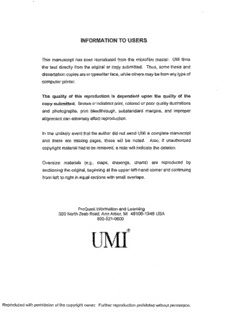
The chemical resistance of polyhexamethylene adipamide PDF
Preview The chemical resistance of polyhexamethylene adipamide
INFORMATION TO USERS This manuscript has been reproduced from the microfilm master. UMI films the text directly from the original or copy submitted. Thus, some thesis and dissertation copies are in typewriter face, while others may be from any type of computer printer. The quality of this reproduction is dependent upon the quality of the copy submitted. Broken or indistinct print, colored or poor quality illustrations and photographs, print bleedthrough, substandard margins, and improper alignment can adversely affect reproduction. In the unlikely event that the author did not send UMI a complete manuscript and there are missing pages, these will be noted. Also, if unauthorized copyright material had to be removed, a note will indicate the deletion. Oversize materials (e.g., maps, drawings, charts) are reproduced by sectioning the original, beginning at the upper left-hand corner and continuing from left to right in equal sections with small overlaps. ProQuest Information and Learning 300 North Zeeb Road, Ann Arbor, Ml 48106-1346 USA 800-521-0600 Reproduced with permission of the copyright owner. Further reproduction prohibited without permission. Reproduced with permission of the copyright owner. Further reproduction prohibited without permission. NOTE TO USERS This reproduction is the best copy available. UMI Reproduced with permission of the copyright owner. Further reproduction prohibited without permission. Reproduced with permission of the copyright owner. Further reproduction prohibited without permission. I THE CHEMICAL RESISTANCE OF POLYHEXAMETHYLENE AD IP AMIDE by Ruth Olive Donohue A Thesis Submitted to the Graduate Faculty for the Degree of DOCTOR OF PHILOSOPHY Major Subject: Textile Chemistry Approved: 7?^ L l In Charge' o£LMajor Work Head^f or Department Dean of Graduate Co Iowa State College 1942 Reproduced with permission of the copyright owner. Further reproduction prohibited without permission. UMI Number: DP12475 UMI UMI Microform DP12475 Copyright 2005 by ProQuest Information and Learning Company. All rights reserved. This microform edition is protected against unauthorized copying under Title 17, United States Code. ProQuest Information and Learning Company 300 North Zeeb Road P.O. Box 1346 Ann Arbor, Ml 48106-1346 Reproduced with permission of the copyright owner. Further reproduction prohibited without permission. T f;>l69 ii D7r'K. TABLE OF CONTENTS Page INTRODUCTION................................... 1 REVIEW OF LITERATURE.................................... 2 Production of Nylons .............................. 2 Properties of Commercial Nylon .................... 7 Uses of Commercial Nylon .......... . . . . . . . 14 ANALYSIS OF THIS FABRIC................................. 17 Materials.................................... 17 Analyses......................................... 21 A s h ......................................... 21 Attempted acetylation of nylon ............... 22 Attempted diazotization of nylon .............. 22 Breaking strength and elongation of fabric at breaking load . . . . . . . . . 23 Dichroism................................... 25 Distribution of yarns by number ........... 26 Distribution of yarns by weight ........... 27 Melting point ............................... 28 Microscopic examination ..................... 29 Moisture ............................... 29 Qualitative tests for sulfur . ................ 30 quantitative estimation of carbon and hydrogen 31 Quantitative estimation of nitrogen ....... 33 Quantitative estimation of titanium....... 34 Thickness of fabric....................... 42 Twist of y a r n ............................... 42 Weight of fabric............................. 43 Yarn number................................ 44 EXPERIMENTAL PROCEDURE ................................. 45 Materials....................................... 45 Mordanting...................................... 50 Preparation of samples....................... 50 Determination of p H ......................... 50 Treatment of the fabric with aluminum sulfate. 51 Treatment of the fabric with potassium dichromate...................... 51 T 7 £ 0 4 Reproduced with permission of the copyright owner. Further reproduction prohibited without permission. lii Table of Contents (Continued) Page Heat .......................................... 60 Treatment of breaking-strength specimens with dry heat................. 60 Treatment of fabric with s t e a m ............. 62 L i g h t ................. 65 Chemical treatment of breaking- strength specimens.................... 65 Exposure of breaking-strength specimens to ultra-violetl ight ................... 67 DISCUSSION OF RESULTS................................ 76 SUMMARY . .......................................... 93 LITERATURE CITED.................................... 96 PATENT INDEX....................................... 118 ACKNOWLEDGMENT........................................ 138 Reproduced with permission of the copyright owner. Further reproduction prohibited without permission. 1 - - INTRODUCTION This investigation v/as undertaken to obtain quanti tative information about the chemical resistance of fi brous polyhexamethylene adipamlde. 1 *■— ■ i»i»n - BwroinnTrriiiiirnmn......... Reproduced with permission of the copyright owner. Further reproduction prohibited without permission. 2 - - HEVIEW OF LITERATURE Production of Nylons The production of a nylon which may be used as a textile was a development of ten yearsf investigation of high polymeric reactions by W. H. Carothers and his coworkers for E. I. du Pont de Nemours and Company (79, 80, 81, 152). Carothers and Hill (84) first succeeded in preparing fila ments from linear superpolyesters (molecular weight, 10,000 to 12,000) made by heating ^-polyesters (molecular weight, 800 to 5000) in a molecular still (75* 83). Fisoher and others (102, 105, 170) had previously prepared polyamides through the conden sation of ^L-amino acids or their derivatives, but these produots had shown no fibrous oharacteristics. Carothers and Hill (82, 86) next reported that a super polyamide from &_-aminooaproio acid was too insoluble and too infusible for spinning but that a mixed polyester-polyamide polymer yielded a considerably stronger filament (85, U. S. Patents 2,071,250 and 2,224,037). Although strong and pliable filaments were also obtained from to-super- polyanhydrides and superpolyacetals, none of these filaments was found to have suitable textile properties (123, 124, U. S. Patent 2,071,252). Carothers and his coworkers continued to Investigate the production of polyamides. British Patent 461,236 describes the Reproduced with permission of the copyright owner. Further reproduction prohibited without permission.
